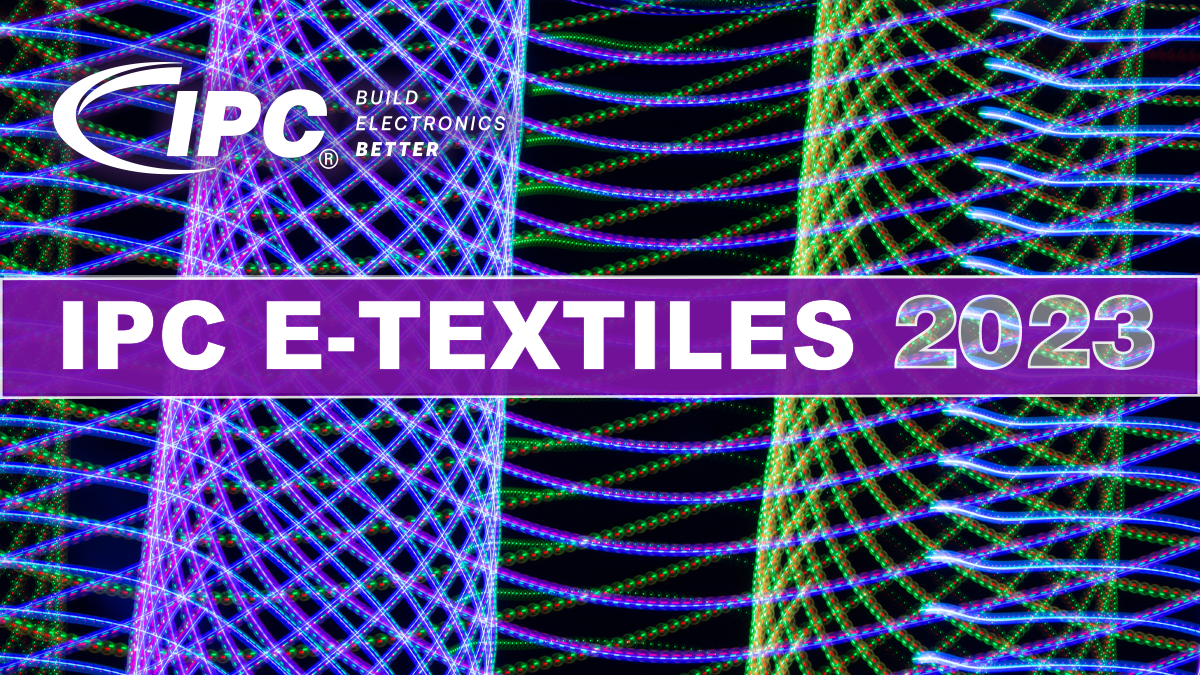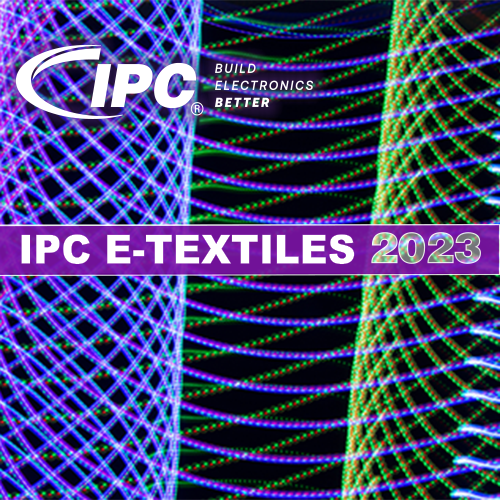EVENT PROGRAM | EXHIBIT | PROFESSIONAL DEVELOPMENT | COMMITTEE MEETINGS | REGISTER
IPC E-TEXTILES 2023, the international conference for the e-textiles industry, will be back live and in person Monday, January 23, 2023 in San Diego, California, in conjunction with IPC APEX EXPO 2023! Professional Development Courses about e-textiles and wearable electronics are also welcome for Sunday, January 22, 2023.
Collaborate with industry leaders in e-textiles technologies in fashion design, health and medical, sports and athletics, automotive, and military/aerospace. Every aspect of the e-textiles supply chain will be represented. This global e-textiles industry event allows product designers, technical experts and company executives from around the world to collaborate on new ideas, view and get hands-on access to the latest innovations, and learn how to build reliable products.
By aligning the conference with IPC APEX EXPO, the premier event for the electronics manufacturing industry, speakers and attendees will also have the opportunity to participate in IPC E-Textiles Committee standards meetings and take advantage of all events and education offered during IPC APEX EXPO.
Event Program
This year’s event will feature 15-minute presentations, lively Q&A discussions with presenters and a panel discussion on the Economic and Business Aspects of E-Textiles. We have also invited all speakers to submit a poster to go with their presentation, so attendees will have additional time for Q&A with speakers during Posters and Exhibits Networking Breaks.
All posters will also be included in the IPC APEX EXPO 2023 Technical Posters Session on the main exhibit hall floor. This will provide additional attention for our speakers to the greater electronics manufacturing industry.
The following topics are confirmed for IPC E-Textiles 2023. Stay tuned for additional topics and the detailed event agenda.
Electronic Textiles Beyond the Body: A Deep Dive Into Use-Cases of E-Textiles for Automotive, Robotics and Beyond
The word "E-textile" often immediately evokes images of smart shirts and shoes. In reality, many strong applications for electronic textiles can be found outside the wearable tech space, opening up opportunities for industry growth. This presentation will discuss use-cases and highlight case studies of e-textile developments in a range of unexpected places. From robotics to automotive interiors, this presentation will discuss where e-textiles can add value to a range of engineers and product developers who work beyond the body.
Reliable Mass Production of E-Textiles by using Embroidery Technology
Embroidery is a textile manufacturing technique that has its roots in historic hand-stitched garment design. However, with the invention of computers, this technique has seen a resurgence due to its high levels of material optimization. Embroidery allows the textile engineer to place single fibers, yarns, fiber bundles, or even wires with high precision in a variable, predesigned geometry. Because of this high precision, embroidery is highly applicable for the reproducible integration of functionality into textiles through textile sensors, actuators, or electrodes. Three types of embroidery technologies are commonly used and defined in the literature. These include chain and moss stitch embroidery, standard embroidery as well as tailored fiber, wire, or tube placement. Each of these methods can be utilized in various ways for the mass production of e-textiles. The embroidery technology offers enormous possibilities for the automatic integration of conductive fibers and electronic parts into textiles to create e-textiles.
E-textiles have been in development for decades but only a few products have made it to the market so far. The main reason for this lack of products on the market is the high production costs. Manual production steps increase the production costs and lead to high product costs. Furthermore, reproducibility cannot be guaranteed with manually created products, which leads to a lack of reliability. Due to the high degree of automation of the embroidery process, a high level of reproducibility can be achieved, enabling the reliable mass production of e-textiles.
Comparison Study of Highly Localized Strain Sensor Versus Motion Capture for Joint Angle Tracking
The evolution of e-textiles has led to the integration of sensors housed very close to the body, often in the sub-mm range. This has allowed for data collection that is so close to the source as to only be rivaled by surgical implants. We looked at kinematic data taken from a person wearing our mm-thick, stretchable fluid phase strain sensors and compared it to literature results of data taken via camera-based motion capture analysis and similar IMU sampling. We found that our strain data taken over joints was equivalent to that of motion capture in terms of raw angle, with a low hysteresis over cycling, and milli-degree precision. It has been shown that embedded textile kinematic sensing could replace more costly systems for capturing 3D motion data and yield similar to superior results.
Advanced Fabric Heating Technologies for Extreme Cold Weather Environments
Extreme cold weather environments result in significant challenges for human performance and general comfort. Heating technologies have quickly advanced in garment platforms over the past 10 years, but still suffer from challenges with respect to power management and distributed heating. Further, garment design highly impacts the efficiency of heat flux to the body, resulting in the need for improved custom manufacturing principles.
This presentation will review the existing principles in heating technologies and lessons learned from strategic customer discovery that explores the multitude of technology growth areas for heating in textiles. Further, a new closed-loop electrical system will be overviewed that utilizes physiological and environmental sensing to control the heating profile in textile processes. This effort is led by the Advanced Functional Fabrics of America (AFFOA), a US Manufacturing Innovation Institute focused on enabling the manufacturability of new textile technologies for the US textile community. The closed-loop system will be a platform that allows for the comparative evaluation and demonstration of new textile heating methods, insulation and reflective materials, battery solutions, and power management algorithms to quickly seeks to provide a comparison between textile material.
Textile-Integrated Liquid Metal Electrodes (TILEs) for Electrophysiological Monitoring
Next-generation textile-based wearable sensing systems will require flexibility and strength to maintain capabilities over a wide range of deformations. However, current material sets used for textile-based skin-contacting electrodes lack these key properties, which hinder applications such as electrophysiological sensing. In this work, we present a facile spray coating approach to integrate liquid metal nanoparticle systems into textile form factors for conformal, flexible and robust electrodes.
The liquid metal system employs functionalized liquid metal nanoparticles that provide a simple “peel-off to activate” means of imparting conductivity. The spray coating approach combined with our functionalized liquid metal system enables the creation of long-term reusable textile-integrated liquid metal electrodes (TILEs). Although the TILEs are dry electrodes by nature, they show equal skin-electrode impedances and sensing capabilities with improved wearability compared to commercial wet electrodes. Biocompatibility of TILEs in an in-vivo skin environment was demonstrated, while providing improved sensing performance compared to previously reported textile-based dry electrodes. The “spray on dry - behave like wet” characteristics of TILEs opens opportunities for textile-based wearable health monitoring, haptics, and augmented/virtual reality (AR/VR) applications that require the use of flexible and conformable dry electrodes.
Architecture Innovations to Optimize E-Textile Performance in Complex Systems
Textiles are simultaneously one of the most ubiquitous, impactful, and unassuming technologies developed in human history. One can easily overlook the subtle technological sophistication behind their unique properties. Dynamically constrained principally by friction, their multiscale structural hierarchy enables the performance, durability, and comfort which we enjoy in our daily lives.
This presentation will discuss novel materials and methods which maximize these inherent textile properties while enabling richly interconnected textile-integrated systems with the same potential for proliferation as those which we wear every day. The Dense Routing for Arrayed Perception Electronics (DRAPE) platform leverages Nautilus’ braided composite microyarns, ZSK’s precision embroidery machines, and SunRay Scientific’s ZTACH ACE anisotropic conductive epoxies to form direct, high-density textile to electronics interconnections suitable for use with chiplet-scale devices. In concert with the University of Virginia’s novel Segment System on Chip, DRAPE has the potential to enable unprecedented performance of textile-integrated networks by supporting heterogeneous protocols in different locations, by providing flexible multi-scale routing, and by enabling easily reconfigurable multi-input, multi-output interconnection of components.
Panel Discussion
This panel discussion features thought leaders and entrepreneurs who are building products, new businesses, and customer opportunities in the advanced e-textiles and wearable e-textiles space. The discussions will offer diverse perspectives for developing advanced material applications that are often uncharted in both product and business development. These leaders will share their unique real-world perspectives on how they had to navigate emerging markets, scout for innovative talent, and develop novel supply chains and manufacturing plans. Their ability to push past these types of pitfalls allows them to develop strategies to persevere and deliver differentiating products.
From this session, attendees will garner a robust understanding of navigating the business of developing e-textiles-based products for defense, to medical and consumer markets.
Session Leader
Yolita Wildman Nugent, Co-founder, Betazip, LLC
Panelists
Vishwa Aluthge, Chief Product Officer, Softmatter
Nat Higgins, Senior Advisor-Human Systems Portfolio, Defense Innovation Unit, US Department of Defense
Venk Varadan, CEO & Co-founder, Nanowear
Arnar Larusson, Founder & CEO, Tyme Wear
Madison Maxey, Founder & CEO, Loomia Technologies, Inc.
Sustainability for Electronics: IPC Leading the Way
Sustainability policies and trends are shaping the lifecycle of textiles and electronics. During this presentation, attendees will learn how IPC is addressing sustainability for electronics through IPC’s Sustainability Initiative, which includes the development of an industry-backed, evidence-based sustainability strategic plan.
This presentation will provide an overview of the Sustainability Initiative, emerging sustainability policies, and IPC-led sustainability projects for 2023.
A brainstorming session will immediately follow the presentation, to allow attendees to collaborate on challenges the e-textiles industry is facing and to share ideas for solutions.
Reliability and Standards of E-Textiles in the Real World
More information coming soon.
Continual Improvements in Printed Heating Circuits for Clothing Garments
Thin, flexible printed heating circuits made with conductive inks were screen printed on thin thermoplastic polyurethane (TPU) films and then mounted on cotton-rich woven and knit fabric panels. The printed circuits can be incorporated into garments such as jackets and other outerwear to provide heat without the bulk of wires. To better understand the behavior and performance of the printed heating circuit, we developed an in-house testing method to monitor the circuit’s durability during laundering and drying cycles. We studied how different types of drying (conventional vs. air) affected the printed heating circuit. The test results helped identify challenges in the printed circuit that were then modified to develop a better-performing flexible heating circuit printed with conductive inks on cotton substrates. The finalized circuit was added to a garment and further trials were conducted to collect data on the printed circuit’s performance during wear. This presentation and final garment are an outcome of the collaborative work done by Cotton Incorporated and Butler Technologies, Inc.
Scalable Production of MXene Dip-Coated Yarns and Cords
Fibers, yarns, and textiles have long established themselves in many sectors of society from our daily wear to medicine and structural composites. The rise of the Internet of Things (IoT) has prompted incorporation of conductive materials into textiles that enable real-time monitoring of external stimuli (e.g., stretch, pressure, temperature, and humidity) and body responses.
Sensors, antennas, energy storage sources need to be incorporated into textiles. New functions, such as IR stealth, EMI shielding or passive and active temperature control, can be enabled by conductive or optically active coatings. Among the many conductive materials and fabrication methods demonstrated, few met the performance and cost requirements of real-world applications.
MXenes are an emerging class of 2D nanomaterials that possess excellent electrical conductivity, attractive optical/plasmonic properties, solution processability and hydrophilic surfaces, making them ideal for imparting conductivity to textiles in a simple dip coating fashion. In this work, a high-throughput continuous coating method was demonstrated with a customized automatic yarn dip coater.
Thanks to the shear force present in the dip coater and the preferred interactions between Kevlar and MXene, viscous MXene solutions and fast coating speeds could be used. Kilometers of highly conductive MXene coated Kevlar cords were produced with consistent quality. Tensile test with in-situ electrical resistance tracking showed the multifunctionality of Ti3C2Tx coated Kevlar for composites, both as structural reinforcement and damage sensing.
Emerging Reliability & Performance Criteria for Wearable Devices
Flexible Electronics industry has relied on the experience from textile, electronics, semiconductor and industry. New FHE products combine electronics functionality and flexible substrates (e.g., textile or plastics) and most previous emphasis was to determine physical limitations. There are three new major failure criteria; to ensure the integrity of new materials and electronics while in continuous use, to detect micro-strain fractures of new materials (e.g., delamination and deformation) and to perform such continuous motion assessments in multi-climate conditions focused on human movement. To this end, our latest prototypes include the PICO a multi-climate (temperature, humidity, liquids fully immersed and integrated with various mechanical motions) and new generation of mechanical testers.
This presentation will showcase continuous tests with accurate, reproduceable mechanical tools, including data harvesting, simple image and third-party device integration, and advanced analytics in hostile conditions to form a repeatable knowledge base to complete the important work of supporting industrial standards. Attendees will gain a broader experience of new materials and manufacturing processes faster to materialize the flexible electronics transformation.
Enabling Stretchable LED Circuits for Wearable Applications Through 3D Geometry
A novel stretchable LED circuit for wearable applications has been demonstrated using 3D helical geometry. Smart textile products have become increasingly commercially available in recent years, and many incorporate flexible electronics, i.e., circuits fabricated on plastic films. However, many smart textile applications require embedded electronics to be stretchable in addition to flexible. For example, smart textiles tracking athlete performance in sports may be embedded in garments made from elastic fabrics and must stretch with the fabric to conform to the body.
Stretchable electronics can be fabricated using plastic films in a planar, serpentine structure, but these can primarily bend along one axis, whereas a 3D helical structure can bend in any direction due to rotational symmetry around its core. Inherently stretchable substrates, e.g., TPU, have also been used to demonstrate stretchable electronics, but these materials are less compatible with standard manufacturing processes involving high temperatures, such as soldering, compared to a helical circuit fabricated on polyimide.
In this research, stretchable LED strips were fabricated as a demonstrator by mounting SMD LEDs on strips of etched copper-clad polyimide. These were then wound around a 4-mm-diameter flexible cord, with components facing inward, and adhered with a flexible adhesive to form a 3D electronic strip (e-strip). The resulting e-strips were subjected to mechanical testing, demonstrating good resistance to cyclic stretching by 30% and bending down a radius of 5 mm. Embedding helical LED strips in clothing could provide illumination for safety or fashion applications, or indicate sensor readings in sports or medical applications.
Investigating Ink–Substrate Compatibility for Printed Metasurfaces
The field of wearable electronics encompasses a wide scope of manufacturing methods, applications, and materials research. Investigations focused on combining materials available on the commercial market accelerate the transition from a laboratory setting to large-scale manufacturing. Additive manufacturing is one such conduit for rapid transition, where techniques such as direct-write or screen-printing are used to match commercial inks and fabrics for wearable devices in communications, energy harvesting, or defense.
In this work, we investigate the advantages and limitations of ink–substrate combinations for wearable RF metasurface fabrication while using RF performance and conductivity as performance metrics. The metasurface was printed on two industrial fabrics with thread masses of 70D and 200D, with applications in ultrasonic welding and tactical apparel or accessories, respectively. Both fabrics feature a woven surface, with a polyurethane (PU) coating on the reverse side. Using two conductive silver ink formulations, the metasurface was printed on both sides for comparison.
Metasurfaces on the PU-coated side of both fabrics yielded unsatisfactory prints with visible discontinuities, high sheet resistance, RS, and poor RF performance compared to those printed on the woven nylon side. This discrepancy was assessed by examining material properties, determining the surface free energy (SFE) and obtaining wetting envelopes using the Owens-Wendt-Rabel-Kaelble (OWRK) model. Curing parameters including temperature and time were considered, accounting for PU breakdown and conductivity decrease.
Investigations revealed that device performance is influenced by materials properties. We anticipate that large-scale screening of commercially available materials will reveal unexpected combinations for optimizing performance in e-textiles.
Re-positionable Textile EMG Electrodes for Physiotherapy in Mobile Rehabilitation
Outpatient rehabilitation is an important pillar of our healthcare system. Integrating exercises into everyday life enables more intensive training and leads to rehabilitation success more quickly. In order to be able to perform exercises independently in addition to regular physiotherapy sessions, the proper execution should be monitored. Textile-based sensors in functional clothing can support both medical monitoring and professional electrode positioning, and disposable electrodes can be replaced by textile-based multiple-use electrodes. However, for the recording of muscle potentials, the quality of the textile electrode as well as the reliable hold at the correct position entail considerable potential for error. According to the current state of the art, it is not possible to record a reliable EMG via textile dry electrodes due to the high contact resistance and the motion artefacts.
In this context, textile EMG (electromyography) dry-electrodes are developed in the research project iTex-4-MoRe to measure not only the quantity of muscle activity but also the quality of muscle coordination. Re-positionable textile electrodes were fabricated from metallized yarns coated with human-toxicologically safe polymers via a nanoscale adhesion promoter layer to withstand stress over many hours of exercise and ensure positioning accuracy. Dry-electrodes are compared and evaluated using both ‘Electric Skin’ and in-vivo models. Thanks to the development, sportswear with EMG electrodes will be part of any physiotherapy and allow online control of training in the future.
Meet the Speakers

Vishwa Aluthge is the Chief Product officer of Softmatter – the smart softgood and tech integration division of MAS Holdings. He is currently focused on both technology pipeline development for Softmatter and concept-to-delivery execution for their customers, and he has over 15 years of experience in the apparel sector in product, operations and innovation.
Vishwa holds a Bachelor’s degree specializing in Software & Computer Science from the University of Colombo and is a Fellow Member of the Chartered Institute of Management Accountants UK (CIMA). He is also a certified PRINCE2 project management professional with other professional qualifications from University of California, Berkeley and NUS, Singapore.

Cotton Incorporated, Cary, NC, USA
Continual Improvements in Printed Heating Circuits for Clothing Garments
Renuka Dhandapani is a Manager in Textile Chemistry Research at Cotton Incorporated with nine years of experience in the textile industry. Her focus has been on formulating new functional finishes to improve the performance of cotton substrate, manage outside research projects, and help develop new markets for cotton. E-Textiles is one such area where she is focused on evaluating the performance and durability to laundering of conductive elements such as the stretchable heaters on cotton. Renuka holds a Ph.D. in Textile Sciences from the University of Georgia and an MS in Design and Merchandising from Colorado State University. She is an active member of AATCC and is the current chair of the Appearance Retention (RA61) Test Methods Committee.

ZSK Technical Embroidery Systems, Krefeld, Germany
Reliable Mass Production of E-Textiles by Using Embroidery Technology
Melanie studied mechanical engineering at RWTH Aachen University in Germany. After earning her diploma, she worked for 5.5 years at the Department of Textile Technologies of RWTH Aachen University as a research assistant. Her research topic was smart and e-textiles. For 2.5 years she was the team leader of the research group Functional Textiles and Smart Textiles.
Melanie worked as a research intern at the Printed, Textile Flexible Electronics (PTFE) Laboratory at Microsoft (Applied Science Group, Surface) in Redmond, WA, USA.
Since June 2016, she has been the Head of Product Design & Innovation of the Technical Embroidery Applications, Smart & E-Textiles department of ZSK TECHNICAL EMBROIDERY SYSTEMS, a division of ZSK STICKMASCHINEN GmbH in Krefeld, Germany.
Together with her team, Melanie is supporting customers all over the world with their e- and smart textiles product development.

University of Massachusetts Lowell, Lowell, MA, USA
Investigating Ink–Substrate Compatibility for Printed Metasurfaces
Adria Kajenski is a PhD student in electrical engineering at the University of Massachusetts-Lowell, with a bachelor’s degree in chemistry from the University of New Hampshire. She is a research assistant at the Printed Electronics Research Collaboration (PERC), a multidisciplinary facility for additive manufacturing in RF and microwave applications. Her research includes materials characterization and e-textile development and testing, with a focus on design and fabrication of printed RF devices on textiles for wearable applications.

Loomia Technologies, Inc., USA
Electronic Textiles Beyond the Body: A Deep Dive into Use-Cases of E-textiles for Automotive, Robotics and Beyond
Madison Maxey is passionate about working at the intersection of design and engineering to create useful products. She studied materials science and engineering at Stanford University and previously worked in design at companies like Tommy Hilfiger.
Currently, she is focused on bringing soft, flexible circuits (e-textiles) to scale through her company, Loomia. Her mission is to create tools for engineers and designers who are creating next-generation products. Throughout the course of her work at Loomia, she has developed e-textile prototypes and workshops for companies like North Face, Google, Flextronics and Adidas.
Her work has built the foundation for six granted patents and has led to invited lectures at universities such as Columbia University, Parsons School of Design, NYU and University of Illinois Urbana-Champagne.

Nautilus Defense
Jim Owens is a mission-driven technologist working in service of a secure and equitable future. As the Founder and Principal of Nautilus Defense, Jim has over 15 years of experience developing and deploying operationally critical sensor systems on six continents. Jim has led Nautilus’ textile-integrated systems research and development efforts for the past eight years with a focus on developing technologies to enable soft systems manufacturing at scale.

CEO & Co-founder, Nanowear
Venk Varadan is the co-founder and Chief Executive Officer of Nanowear, a growth stage, healthcare-at-home digital monitoring and machine learning diagnostic platform. Nanowear’s SimpleSense platform is the first-and-only healthcare-at-home platform powered by proprietary FDA-approved, cloth-based nanotechnology, which simultaneously and time synchronously monitors and assesses the heart, lungs, central vascular and hemodynamic systems by replacing seven first-line diagnostics tools.
Nanowear’s quality and quantity of data is unparalleled in the hospital-at-home market, enabling unique deep learning-driven digital “risk" signatures specific to each patient’s unique 85+ biomarkers while they are in the comfort of their own home.
Before Nanowear, Venk spent seven years at UBS Investment Bank, Citadel Investment Group and Wells Fargo Securities in New York, with focus on venture-backed enterprise software and communications technology. Prior to his finance career, Venk spent three years in product marketing and sales with both Lilly and Sanofi Pharmaceuticals in New York.
Since 2011, Venk has been a Board Director of the Center for Arts Education, a non-profit organization committed to ensuring that all New York City public school students receive quality arts instruction as part of their pre-K-12 education.
Venk received his Masters of Business Administration from Columbia University and his Bachelors of Science and Engineering from Duke University.

Drexel University
Scalable Production of MXene Dip-Coated Yarns and Cords
Lingyi Bi is a Materials Science and Engineering PhD student at Drexel University. Her research is focused on developing functional fibers, yarns and fabrics by incorporating a new family of two-dimensional materials, MXenes. She is especially interested in exploring scalable processes such as screen printing and dip coating to leverage the versatility and tunability of MXenes for applications such as energy storage and sensing. Before coming to Drexel, she had years of textile R&D experience in both international companies and startups, from fashion to sportswear. She holds a MS in Innovation Management and Entrepreneurship from Brown University and BS in Textile Engineering, Donghua University, China.

Butler Technologies Inc., Butler, PA, USA
Continual Improvements in Printed Heating Circuits for Clothing Garments
Tyler Dunbar is the Research and Development Manager at Butler Technologies, Inc. (BTI), with eight years of experience in manufacturing and product testing. He has spent most of his career engineering and testing ballistic glass for the Defense Industry but has recently transitioned into the world of Printed Electronics.
Tyler is currently focusing on developing new conductive solutions with flexible and stretchable form factors. Current work includes developing new and useful applications for printed biometric sensors and printed, stretchable heaters, as well as developing efficient and easy to use connection methods. Tyler holds degrees in Physics from Slippery Rock University of Pennsylvania and Mechanical Engineering from Youngstown State University. His past work includes research on liquid crystal 5-CB with suspended gold nanoparticles and the design, optimization, and manufacture of a 3D printed aluminum thermal management system which launched on a NASA CubeSat.

Liquid Wire, Portland, Oregon, USA
Comparison Study of Highly Localized Strain Sensor versus Motion Capture for Joint Angle Tracking
Mike Hopkins is a PhD of Physics with deep experience leading cross-disciplinary research teams and driving advances in flexible electronics for over 10 years. His work at Liquid Wire focuses on utilizing liquid metal conductors in stretchable circuits, strain sensors, and pressure sensors for a range of applications including physiological monitoring of muscle and joint movements and VR gesture control.

Founder & CEO, Tyme Wear
Arnar Larusson is the founder and CEO of Tyme Wear where he oversees customer and product development of their soft sensing technology currently used by Olympians, Professional, and amateur athletes around the world. Prior to starting Tyme Wear, he helped develop the world's first soft exosuit funded by DARPA at Harvard University, and prosthetic knees for amputee athletes at Össur in Iceland.
Arnar has a degree in Mechanical Engineering from the University of Iceland.

Textile Research Institute Thuringia-Vogtland e.V., Greiz, Thuringia, Germany
Re-positionable Textile EMG Electrodes for Physiotherapy in Mobile Rehabilitation
Pulkit holds a Master of Science degree in Technical Textiles from the Niederrhein University of Applied Sciences in Germany. In his thesis, he worked proactively to design and fabricate an intelligent compression bandage with textile electrodes for bioimpedance measurement on extremities during compression therapy. The work was successfully patented in Germany and internationally.
During his studies, he worked as a research assistant at the Textile and Clothing Research Institute of his university and conducted numerous projects in different areas of the textile chain, such as sustainable dyeing, digital printing, cosmetotextiles and smart textiles. He currently works as a project manager and research associate at the Textile Research Institute Thuringia-Vogtland in Greiz. There he is involved in national and international projects related to the research and development of smart medical textiles. He plans to further pursue PhD in the similar field to promote the application of smart medical textile and clothing in the future.

Nottingham Trent University
Enabling Stretchable LED Circuits for Wearable applications through 3D geometry
Jessica Stanley is a PhD candidate in the Department of Engineering at Nottingham Trent
University in the UK. She holds a MSc in Experimental Physics from Utrecht University (NL), a BA in Theoretical Physics from Trinity College Dublin (IE), and is a graduate of Fabricademy, a distributed textile academy at the intersection of textiles, technology and biology. Having previously worked in informal science education and interdisciplinary art and science projects, her current work focuses on manufacturing methods for e-textiles, developing flexible and stretchable electronics for sport and medical applications.

Nat Higgins, Senior Advisor-Human Systems Portfolio, Defense Innovation Unit, US Department of Defense
Nat Higgins is the Senior Advisor to the Human Systems Portfolio for the Defense Innovation Unit (DIU) at the U.S. Department of Defense. DIU partners with the nation's leading commercial technology companies to develop and field cutting-edge commercial capabilities to the military faster and more cost-effectively than traditional defense acquisition methods.
In this role, Nat's responsibilities include providing guidance on policy and strategy issues for the Director of Human Systems, leading multidisciplinary teams composed of both government and commercial representatives to rapidly solve critical national security problems, and scouting commercial capabilities across numerous industry verticals including wearables, digital health, telecommunications, virtual reality and AI/ML.
Prior to this role, Nat worked for Abbott Laboratories where he helped grow the diagnostics divisions northeast footprint from last out of five major competitors to market leader within three years. While at Abbott he also took part in a rotational leadership program that exposed him to a range of innovative business practices across Abbott's healthcare divisions.
In his Army career he served as the Executive Officer of a military police company at US Army Garrison Grafenwoehr, Germany and as a Platoon Leader in both Germany and Afghanistan. While serving in Operation Enduring Freedom, 10-11 he planned and led over 150 combat, law enforcement, and humanitarian missions and his unit was instrumental in recruiting and training the first Afghan Local Police forces in theatre.
Nat graduated with a BA in Law and Society from the University of California at Santa Barbara in 2008. In 2020 he received his Master's in Global Governance, Politics and Security from The American University, School of International Service.

Director of Ecosystem Technology
AFFOA (Advanced Functional Fabrics of America), Cambridge, MA, USA
Advanced Fabric Heating Technologies for Extreme Cold Weather Environments
Dr. Jesse Jur is currently on scholarly reassignment at Advanced Functional Fabrics of America (AFFOA) as the Director of Ecosystem Technology. In this role, he leads efforts to discover and foster advanced textile technologies and capabilities for both the commercial and defense markets. Dr. Jur is also a professor of Textile Engineering Chemistry & Science at NC State University’s Wilson College of Textiles where he leads a multidisciplinary research team on system design and manufacturing of smart textiles. Specifically, his research team develops materials processes to increase the breadth of the electronic functionalization of textiles, explores simulations methods of smart textile systems, and advanced automation in textile manufacturing. His research & development activity as well as product and entrepreneurial teaching portfolio is inspired by the challenges faced in advancing the textile industry.

Air Force Research Laboratory, Wright-Patterson AFB, OH, USA
Air Force Life Cycle Management Center, Wright-Patterson AFB, OH, USA
Textile-Integrated Liquid Metal Electrodes (TILEs) for Electrophysiological Monitoring
Braden Li received his B.Sc degree in Materials Science and Engineering from the Herbert Wertheim College of Engineering at the University of Florida (2017) and his Ph.D. in Fiber and Polymer Science from the Wilson College of Textiles at North Carolina State University. He is currently a U.S. Department of Defense (DoD) SMART scholar and Materials Research Engineer with the U.S. Air Force. His role focuses on collaborative acquisition and development efforts towards next-generation electronic textile technologies with the Air Force Life Cycle Management Center (AFLCMC) and Air Force Research Laboratory (AFRL).

Yolita Wildman Nugent has 20 years of experience in designing, building and manufacturing complex flexible systems that merge textiles and electronics at institutes including MIT and the US Department of Defense. She also founded the advanced Soft Systems group at tech company FLEX.
After studying Apparel Design at the Rhode Island School of Design, Nugent entered the apparel industry, working in product development and manufacturing, and managing the process from concept stage through to volume production of 800 styles a year.
Looking to experiment again, she next moved into positions that pushed the limits of textiles and their applications, including e-textiles. This included working with the US Department of Defense on innovation and with a team developing advanced fibers and weaves to protect soldiers from high-velocity fragmentation threats from improvised explosive devices (IEDs). She also researched methods to sense damages in ballistics that could diminish their effectiveness by using a conductive fiber matrix acting as a sensor grid to alert the wearer of potential damage.
At MIT Media Lab, Nugent consulted on wearables and e-textile projects that incorporated smart textiles to develop tactile sensors. While at technology solutions company FLEX, she designed, built and led the first soft systems and etextile team at one of the largest contract manufacturers in the world. Her interdisciplinary team combined expertise in textiles, materials, mechanical, electrical and software to become one of the most diverse and inclusive engineering teams at the company.
Yolita is active in IPC e-textiles standards development as a member of the D-72a Conductive Yarns for E-Textiles Task Group, D-72b Woven, Knitted and Braided E-Textiles Standard Task Group and D-75a E-Textiles Wearables Standard Task Group, as well as IPC A-Teams for e-textiles wearables.

Founder/GM, Bayflex Solutions, San Jose, CA, USA
Founded Bayflex Solutions, a San Francisco Bay area based developer of flexible electronics reliability systems, adding value in continuous testing equipment and data analytics platforms. Bayflex represents Yuasa Systems, a manufacturer of modular endurance systems in North America, Europe and the Middle East.
Additionally, through his corporate venture group, Nikkei Ventures, is actively involved in early-stage investments in flexible electronics and bridging Asia with North America/European partnerships.
Previously, Tsuyuzaki was the Chief Technology Officer and Corporate Vice President for Corporate Development at Panasonic, where he led numerous teams in innovations in product and services spanning concept, standardization and corporate partnerships.
Tsuyuzaki holds a BSc in economics from Tokyo’s Sophia University and graduated from the University of California/Los Angeles and Stanford graduate school of business. He was awarded an Emmy, and Home Media’s Home entertainment visionary award.

Kelly Scanlon leads IPC’s advocacy efforts as the association’s director of environmental policy and research. She works on IPC’s Global Government Relations team in Washington, DC. There, she coordinates with IPC’s North American and European Government Relations Committees and the Environment and Health Strategic Management Team to develop robust policy and research agendas. Kelly has more than 20 years of experience as a public health scientist supporting academic and government institutions. She has her doctorate and a master’s degree both in public health and she is a certified industrial hygienist.
When you register for IPC E-Textiles 2023, be sure to also register for this IPC APEX EXPO 2023 professional development course.
IPC APEX EXPO Course Title: Electronic Textile Evaluation Methods for Product Engineers and Designers
Instructor: Madison Maxey, Loomia Technologies, Inc.
Date: Sunday, January 22, 2023
Time: 3:30-6:30

Madison Maxey is passionate about working at the intersection of design and engineering to create useful products. She studied materials science and engineering at Stanford University and previously worked in design at companies like Tommy Hilfiger.
Currently, she is focused on bringing soft, flexible circuits (e-textiles) to scale through her company, Loomia. Her mission is to create tools for engineers and designers who are creating next-generation products. Throughout the course of her work at Loomia, she has developed e-textile prototypes and workshops for companies like North Face, Google, Flextronics and Adidas.
Her work has built the foundation for six granted patents and has led to invited lectures at Universities such as Columbia University, Parsons School of Design, NYU and University of Illinois Urbana-Champagne.
Electronic textiles present a new and exciting frontier for product developers, with the industry growing at a 20.5% CAGR. However, these new materials often present evaluation challenges that keep products from market shelves. For many engineers and designers, it's not clear if these soft, flexible circuit form-factors should be evaluated using electrical testing methods, materials testing methods, or textile-specific testing methods.
This professional development course is designed to provide a primer to electrical and mechanical engineers - as well as product designers - on how to engage with electronic textiles for new product development. Attendees should walk away with a clear picture of when electronic textiles may be relevant to their engineering, which type of technology is ideal for their application, and how to thoroughly evaluate a technology when selected.
This course will be structured as follows:
1.) Overview of electronic textiles as an engineering tool (40 min) + 10 min break
2.) Landscape of existing e-textile methods and their related pros and cons (40 min) + 10 min break
*this section will include a show and tell of technologies*
3.) Deep-dive on evaluation methods for electronic textile technologies (40 min)
4.) Q&A (30min)
The IPC E-Textiles Committee has scheduled its task group meetings for its international standards development projects to take place Tuesday, January 24 and Wednesday, January 25. All meetings are open to anyone to attend, but you must select Committee Meetings as part of your registration package. There is no cost if you register by January 21. After that, the registration fee is $50.
You do not need to register for individual meetings. Your committee registration will provide you access to all committee meeting rooms.
Wednesday, January 25
D-75c E-Textiles Printed Electronics Reliability Standard Task Group
8:00 AM to 10:00 AM
D-75a E-Textiles Wearables Standard Task Group
10:15 AM to 12:00 PM
D-75b E-Textiles Wearables Guideline Task Group
1:30 PM to 3:00 PM
Members: $355
Nonmembers: $445
IPC E-Textiles registrants will use the IPC APEX EXPO 2023 registration system for this year’s event. Register for IPC E-Textiles 2023 by choosing any IPC APEX EXPO package. Add IPC E-Textiles as an additional item. This registration includes the Monday luncheon featuring a keynote by: Shawn DuBravac, IPC Chief Economist.
If you plan to attend the professional development course, you can select that under Professional Development Half-Day Courses.
If you have any question regarding your registration contact Kim DiCianni.
Director Tradeshows & Events
Tel: +1 847-597-2823
We also recommend registering for the following additional IPC APEX EXPO items at a minimum:
Committee Meetings – FREE before January 21
This grants you access to the E-Textiles Committee meetings and all other standards development committee meetings during the week.
Event Essentials Pass – FREE before January 21
Includes IPC APEX EXPO 2023 Exhibit Hall, where you will be able to peruse the latest technologies in electronics manufacturing and the IPC APEX EXPO 2023 and IPC E-Textiles 2023 Poster Presentations. We will have dedicated posters networking during the Tuesday Show Floor Welcome Reception and the Wednesday Ice Cream Social on the Show Floor.
This registration option also includes the IPC APEX EXPO 2023 Opening Keynote Session, Newcomers Networking Reception, Women In Electronics Networking Reception and New Products Corridor.
Tuesday and Wednesday Luncheons with Keynote Session – $60 each
If you plan to stay for the E-Textiles Committee meetings and/or additional IPC APEX EXPO 2023 programming, register for the Tuesday and Wednesday luncheons, where you will have additional time to network and learn about the latest from IPC.
Exhibitors and Media Supporters
Tabletop Exhibits
- One six foot draped table
- Sponsor logo will be prominently displayed on conference website, event promotional materials and on-site signage.
- One complimentary conference registration for your exhibit staff
IPC Member: $750
Nonmember: $900
For more information about tabletop exhibits and sponsorship opportunities, please contact Chris Jorgensen, IPC Director of Technology Transfer at ChrisJorgensen@ipc.org.
IPC E-Textiles 2023 Program Committee

Vladan Koncar is Distinguished Professor (Classe exceptionelle) at ENSAIT (Ecole Nationale Supérieure des Arts et Industries Textiles) textile engineering institute in Roubaix, France – at University of Lille. He obtained his Ph.D. in 1991 at the University of Lille 1 in Villeneuve d’Ascq.
From November 2009 to November 2015 he was Head of Research at ENSAIT and Director of GEMTEX research laboratory. Professor Koncar was AUTEX (Association of Universities for Textiles) President from June 2007 to June 2010.
Professor Koncar has also been Deputy Director of ENSAIT from 2005 to 2007 and Director of International Relations from 2007 to 2009. He still serves as an elected member of the ENSAIT Governing Board.
He has been promoted to Doctor Honoris Causa of the University of Iasi, Romania in January 2010.
Professor Koncar was the Scientific coordinator and Coordinator of Large-Scale EU Integrated Projects in FP7 and Horizon 2020 and Coordinator of National (French) research projects.
His research interests cover the area of flexible textile sensors and actuators, smart textile structures, and modeling and control of complex systems. He teaches in the area of Automation, Computer Networks, Virtual Reality, and Smart textiles.
Professor Koncar is also General Chair of the IPC D-70 E-Textiles Committee and chair of the IPC D-75a E-Textiles Wearables Standard Task Group.

Yolita Wildman Nugent has 20 years of experience in designing, building and manufacturing complex flexible systems that merge textiles and electronics at institutes including MIT and the US Department of Defense. She also founded the advanced Soft Systems group at tech company FLEX.
After studying Apparel Design at the Rhode Island School of Design, Nugent entered the apparel industry, working in product development and manufacturing, and managing the process from concept stage through to volume production of 800 styles a year.
Looking to experiment again, she next moved into positions that pushed the limits of textiles and their applications, including e-textiles. This included working with the US Department of Defense on innovation and with a team developing advanced fibers and weaves to protect soldiers from high-velocity fragmentation threats from improvised explosive devices (IEDs). She also researched methods to sense damages in ballistics that could diminish their effectiveness by using a conductive fiber matrix acting as a sensor grid to alert the wearer of potential damage.
At MIT Media Lab, Nugent consulted on wearables and e-textile projects that incorporated smart textiles to develop tactile sensors. While at technology solutions company FLEX, she designed, built and led the first soft systems and e-textile team at one of the largest contract manufacturers in the world. Her interdisciplinary team combined expertise in textiles, materials, mechanical, electrical and software to become one of the most diverse and inclusive engineering teams at the company.
Yolita is active in IPC e-textiles standards development as a member of the D-72a Conductive Yarns for E-Textiles Task Group, D-72b Woven, Knitted and Braided E-Textiles Standard Task Group and D-75a E-Textiles Wearables Standard Task Group, as well as IPC A-Teams for e-textiles wearables.

Pratyush Rai (PhD) is Founding Engineer and Chief of Research & Development at Nanowear Inc.
Dr. Rai received his Doctorate in Biological Engineering from University of Arkansas and his Bachelor's of Technology from Indian Institute of Technology Madras.
Prior to his role at Nanowear, Pratyush has pursued an academic career at Electrical Engineering, University of Arkansas as Research Associate. He has more than 12 years of experience in research and development in e-textile-based medical devices, Nanotechnology, and Biomedical Engineering.
At Nanowear, he leads the research and development of cloth-based nanosensor systems for remote monitoring of patients. He has led successful development and rollout of multiple wearable e-textile-based medical products. His fields of expertise include e-textile device design, biomedical systems, nanomaterials synthesis and characterization, medical device development process including design control, clinical study design and testing, FDA 510(k) regulatory strategy, e-textile manufacturing process design and automation. His research work has been published in top journals in Engineering. He is the co-inventor of multiple patents on the novel cloth-based nanosensor technology, nanosensor manufacturing, microscopy, and AI/ML based remote monitoring.
He is actively involved in consortiums for advancing the functional e-textiles industry (representing Nanowear at AFFOA) and committee for industrial standards for e-textile (IPC and AATCC).
He is currently a chairman of IPC D-73a E-Textiles Printed Electronics Design Standards Task Group for IPC 8952 and D-74a E-Textile Test Methods Development and Validation Subcommittee. He was a member of the D-72 Subcommittee for IPC 8921 Requirements for Woven and Knitted Electronic Textiles (E-Textiles) Integrated with Conductive Fibers, Conductive Yarns and/or Wires.

Sahar Rostami is a Sr. Textile Engineer at Myant. She received her bachelor’s degree in Textile Engineering in 2015 from Amirkabir University of Technology in Iran. She worked in different areas of textiles from fiber and yarn production to functional jacket manufacturing. She joined Myant in August 2019 with a passion for working on functional textiles and e-textiles. She has conducted research on the washability of smart textiles, reliability of conductive yarns and fibers as well as investigation on several methods for integration of smart textiles and e-textiles.
She is also a leader and member of multiple IPC task groups developing standards and test methods to fill the gap between the consumer market and industry for e-textile products and wearables. Sahar is currently the chair of IPC D-72b Woven, Knitted and Braided E-textiles Task Group for IPC-8921 and the vice-chair for IPC D-72a Conductive Yarns for E-Textiles Task Group for IPC/JPCA-8911. She is a member of the D-75a E-Textile Wearables Standard Task Group, D-73a E-Textiles Printed Electronics Design Standard Task Group as well as multiple IPC A-Teams for e-textiles standards development.
Get Social
Download any of the below images and share them on your social media platforms using the hashtag: #IPCEtextiles.
 |
Resource: IPC E-Textiles 2023 Banner Dimensions: 1600x350 File Type: PNG Download |
 |
Resource: IPC E-Textiles 2023 Dimensions: 1200x675 File Type: PNG Download |
 |
Resource: IPC E-Textiles 2023 Dimensions: 500x500 File Type: PNG Download |
IPC E-Textiles Initiative - Get Involved Today
Questions about becoming a speaker?
Julia Gumminger
Questions about registration?
Kim DiCianni
Questions about becoming a sponsor?
Chris Jorgensen

